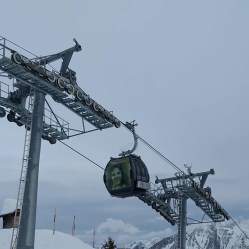Tis The Season, for those who are so inclined, to loft themselves to the top of a steep snow-covered hill and then go downhill, really fast. And if something gets in their way, turn. Whether they be on skis, a snowboard, or some other means, getting down usually involves using gravity. Getting up, on the other hand, usually involves a ski lift. And in the video by [kalsan15] after the break, we learn how technology has stepped in to make even the most inaccessible slopes just a lift ride away.

In its most simple form, a ski lift is two pulleys connected by a steel cable. The pulley at the bottom of the hill is powered, and the pulley at the top of the hill serves as an idler. Attached to the steel cable are some means for a person to either sit down or grab a handle and be hoisted to the top of the hill.
Such a simple arrangement works fine if the geography allows for it, but what if there are turns, or there need to be multiple idlers to keep the wire taut but also close to the ground? Again, the most basic ski lifts have limitations. If the cable turns left around the idler, then the attachment for the handle or chair has to be on the right, making a right turn around the idler an impossibility.
How then can this problem be solved? We won’t spoil the outcome, but we recommend checking out [kalsan15]’s video for an excellent description of the problem and the solution that’ll leave you wondering “Why didn’t I think of that!?”
If you don’t find this hacky enough, then take a moment to learn how you too can not just make a gas-powered ski lift for your cabin in the woods, but then ride your slope down on your DIY Ski Bike!

















There’s so little actually holding you to the wire.
It makes me wonder if they would have more luck using strong magnets.
That would be impossible. The chairlift grips attached to the cable are extremely safe is. Each grip is texted each year let’s hope they, as well as relocated on the cable each year. Every year 10 percent of the grips from each lift are sent off to a laboratory and X-rayed looking for ANY fractures. I worked at ski resorts from 1970 to 1994. . The process is called Magafluxed
That was a surprisingly informative video with a really interesting engineering solution
Agree!
I wish they would heat the seats on the lift. That was be awesome
Here in Austria there are some lifts with heated seats. I personally think it is really uncomfortable and a waste of energy. Cold wind coming from the front and heating from the back doesn’t really help. If it is turned up to much you get sweaty while beeing on the lift and really cold while skiing down.
A cover is much more comfortable as it prevents the wind.
I went to Interlaken Switzerland in 1986 and they had a chair lift where you sat sideways and there were huge leather curtains that surrounded you (you couldn’t see out) and they gave you massive fur lined jackets for the ride. The skiing was so much better than New England.
I skied Gore in NY and they gave us canvas ponchos to wear up the lift because it was -20 f. They were needed.
There are lots of sit- and cabin-lifts that have heated seats. Doubt you’ll find any T-bar or button lifts with heat though…
The two wires will also double as + and – for DC seat heat :-)
But, if it can be done… it’s not impossible. Right?
Didn’t watch fully or with audio, but there were TWO methods to over come the problem.
One being the “no left turn” solution for traffic (LHD), the other being more expensive.
Two wrongs don’t make a right, but three lefts do…
Kept waiting for it to show “passengers falling to their almost certain deaths”
T-Bars … nice to see that this endangered species has found a retreat, at least in Switzerland ;-) All larger ski resorts in the Alps now only have high-performance chair or cable car lifts. Fast and – of course – heated. BTW: who can still safely use T-bars? I don’t ;-)
I believe tow ropes are still used at smaller regional slopes in the USA 🇺🇸
In Australia I believe they still use quite a few “nutcracker” lifts, which are rope tows where a gripping device attached to a belt with by the user is used to prevent arm fatigue and also allow the rope to ride over intermediate sheaves, allowing for longer lifts than would be possible with a regular rope tow.
Thanks, great video! We still have lots of t-bar lifts for the “bunny slopes” in our region (Vermont, USA).
Modern T bars still run as they are the only option in high wind locations. They still run when the chairs and gondolas shut down due to wind. Look at Breckenridge. And it is very entertaining watching the snowboarders try, and fall down.
Excellent video!
There’s another good one on the same channel which goes behind the scenes at the Flaschen gondola lift: https://www.youtube.com/watch?v=HhI_1Yi5CtQ
The disadvantage is that you need to double almost everything, cable, sheaves, mounting points, etc, with commensurate increase in cost. I guess the major capital expense, though, is construction of the towers, the drive system, and the cable, and only one of those is doubled in this design. Very clever!